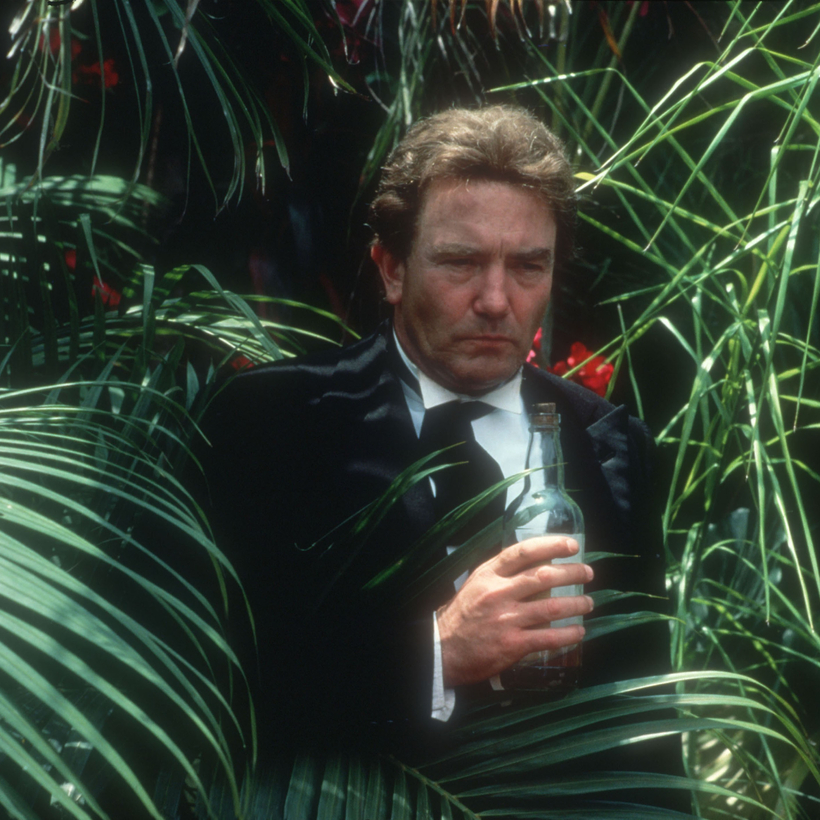Readers of this book will need a strong black coffee by the end. It’s not just the oceanic vats of booze consumed by its subjects that will make your head spin; the cures and pick-me-ups on which they rely are equally alarming. Such as Anthony Burgess’s favorite, Hangman’s Blood: “Into a pint glass doubles of the following are poured: gin, whisky, rum, port and brandy. A small bottle of stout is added and the whole topped up with champagne or champagne-surrogate. It tastes very smooth, induces a somewhat metaphysical elation, and rarely leaves a hangover.”
A similarly omnibibulous approach is taken by Sasha, the fictional alter ego of Jean Rhys in Good Morning, Midnight, who cries: “I’ve had enough of thinking, enough of remembering. Now whisky, rum, gin, sherry, vermouth, wine with the bottles labelled ‘Dum vivimus vivamus’ [‘While we live, let us live’] … Drink, drink, drink … As soon as I sober up I start again.” But when it comes to extreme consumption, even Rhys is eclipsed by Malcolm Lowry, author of Under the Volcano. “He would drink anything,” his wife wrote. “Tequila, mescal, whisky, gin, beer, rubbing alcohol, after-shave lotion and hair tonic.”
There already exists a substantial shelf of books on writers and heavy drinking, headed by The Thirsty Muse by Tom Dardis and The Trip to Echo Spring by Olivia Laing. Now William Palmer takes a slightly stern look at “the effect that heavy drinking had on writers … and how they described the private and social world of the drinker in their work”. His chosen alcoholic cricket team are Burgess, Rhys, Lowry, Patrick Hamilton, Charles Jackson, Dylan Thomas, Elizabeth Bishop, John Cheever, Flann O’Brien, Kingsley Amis and Richard Yates.
A Sober Look
Palmer guides us skillfully through their fictional boozing. We see Hamilton spend eight chapters of The Midnight Bell describing pub life from the unbolting of the door to the calling of “Time!” — his evocation of that moment, says Palmer, “calls to mind those paintings of the expulsion from the Garden of Eden in which a stern God’s finger appears from between clouds, pointing to the exit”. Pubs in Burgess’s novels are places where strangers create mystery and danger, generating chaos and near-surrealist happenings. The entire action of Lowry’s Under the Volcano unfolds in 12 hours of nonstop drinking based on his life in the cantinas of Cuernavaca, Mexico.
Palmer warns that “the attempt to concoct theoretical psychological explanations for the behaviour of others… is likely to be both impertinent and inaccurate.” It doesn’t stop him diagnosing the roots of his subjects’ dipsomania in many things: depression following sexual betrayal (Rhys), embarrassment about being gay (Jackson), lesbian confusion (Bishop), bisexual promiscuity (Cheever) and unrequited love following a disfiguring accident (Hamilton). It’s all about sex. Lowry’s drinking is linked to his insecurity with women: he was the butt of many jokes about his small penis, and could avert premature ejaculation only by singing The Star-Spangled Banner.
Palmer is good at debunking tall stories. He argues that Thomas’s public drunkenness was often a performance to please an audience: he could be talking soberly to a friend in a pub, only to appear utterly sloshed when others came through the door. That doesn’t mean he couldn’t be a shocking embarrassment, though: when really drunk, he would impersonate a dog, pawing across the pub floor on all fours, begging to be patted.
One place that sees a lot of action is the Bellevue Hospital, New York, America’s No 1 drying-out clinic; a combination of recovery ward, mental asylum and screeching hellhole. Charles Jackson was sent there in 1936 and it makes harrowing reading: the cesspool smell, the tough male-nurse jailers, the new arrival: “He kept up a high keening wail, and when they got him to the bed he started screaming that it was on fire.”
By coincidence Malcolm Lowry also entered Bellevue in 1936, and emerged convinced that he and his fellow inmates were damaged angels. Richard Yates, the author of Revolutionary Road, was sent there by a doctor in 1961. He was taken, struggling and yelling obscenities, to the atrocious Men’s Violence Ward in a wheelchair with “PSYCHO” stenciled on the back.
When really drunk, Dylan Thomas would impersonate a dog, pawing across the pub floor on all fours, begging to be patted.
A strong whiff of disapproval comes from Palmer when choosing examples of his authors’ plunges to rock bottom. Considering Patrick Hamilton’s terminal depression, we’re told: “He now read only trash and had little interest in any of the other arts.” (So, the bedridden Hamilton neglected to visit theaters and galleries?) Jean Rhys’s last marriage was also a nosedive into depravity: “Max was not a success in his career and they were soon in financial difficulties. They moved out of London to a flat in suburban Beckenham.”
An enjoyable feature of this entertaining book is its abrupt digressions and switchings of mood.
While discussing the fictional pub in Burgess’s The Right to an Answer, Palmer digresses into a four-page blizzard of clichés describing a “typical” real-life pub in 1950s England, its rooms, furnishings, landlord and clientele.
Speculating about how a movie of Bishop’s life would portray her, he wonders: “Was there ever a Hollywood biopic about a poet?” (At least two dozen, by my reckoning.)
Discussing the miscasting of Ian Carmichael as the bespectacled hero of the Lucky Jim film, he wonders if short-sightedness might be the reason for the lack of physical description in Amis’s fiction.
At such moments, you find yourself wondering if the author might himself have had a couple of sherbets, mid-composition.
John Walsh is a former literary editor of The Sunday Times and editor of The Independent Magazine

